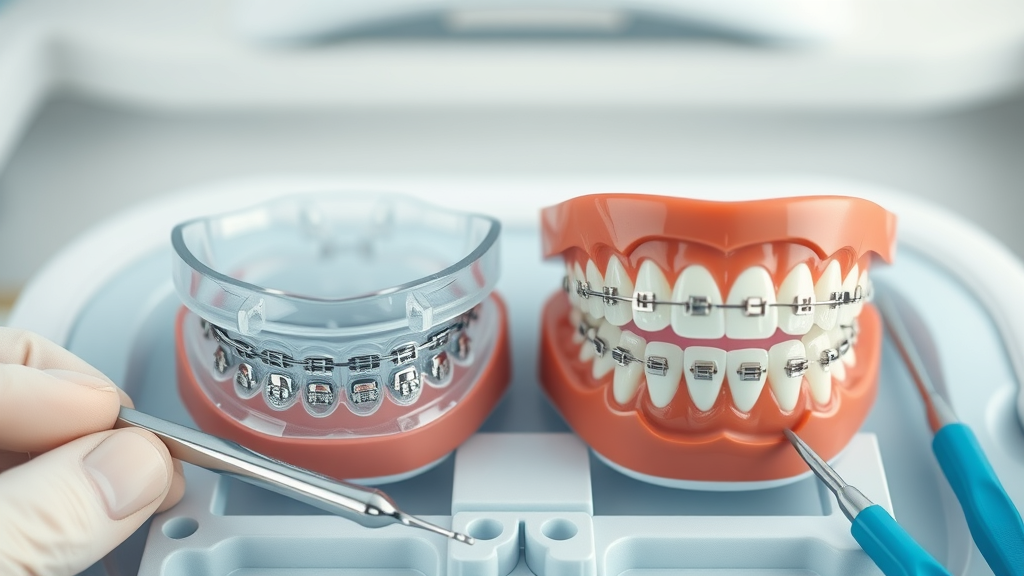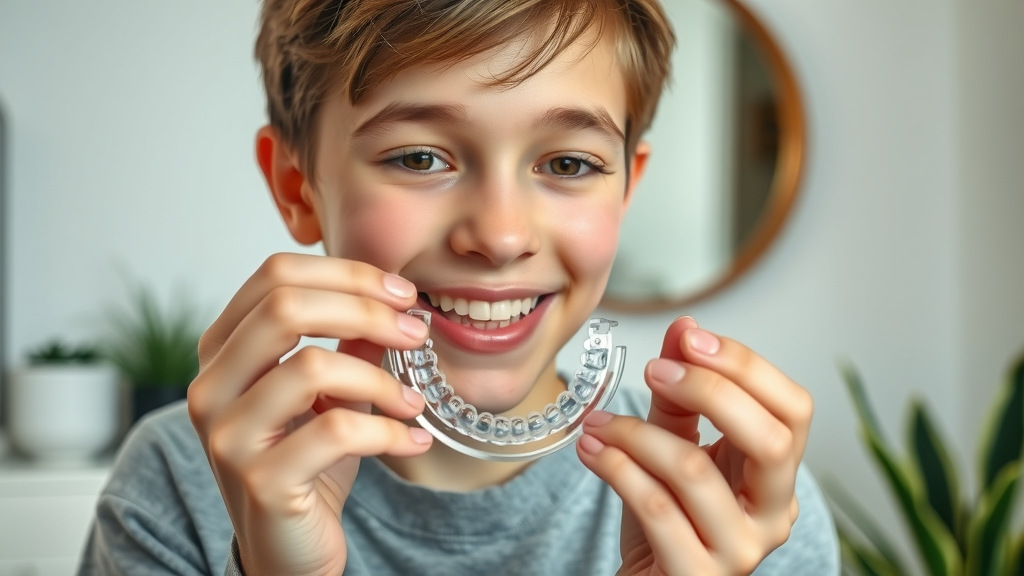Have you ever wondered if clear aligners could get you a straight smile faster than traditional metal braces? With so many choices for orthodontic treatment, understanding which option can deliver results more quickly is crucial for anyone eager to improve their smile—especially with busy lives and packed schedules. In this comprehensive guide, you’ll discover everything you need to know about treatment time: do aligners really work faster than braces? and how to make a confident, informed decision with your orthodontist.
Unlocking the Truth: Treatment Time – Do Aligners Really Work Faster Than Braces?
When it comes to orthodontic treatment, the biggest question many patients ask is about treatment time. Are clear aligners really better than traditional metal braces when you want faster results? This article will help you cut through the hype and look at the real evidence, so you can answer: “Do aligners work faster than braces?” right from the start.
We know that time spent in braces or aligners can affect your lifestyle, confidence, and oral health. While metal braces are tried and true for all ages and issues, new technology like Invisalign aligners keeps making headlines for promising speed, comfort, and discreet treatment. But does new mean faster and better?
Below, we’ll compare how braces work versus aligners, what the research says about treatment time, and why your specific dental problem or lifestyle might make one option better for you. By the end of this article, you’ll know where to turn for speedy, reliable care and what questions to ask your orthodontist.

What You'll Learn in This Guide to Treatment Time: Do Aligners Really Work Faster Than Braces?
- The fundamental differences between clear aligners and traditional metal braces
- How treatment time compares for metal braces versus aligners
- What clinical research reveals about which method can work faster
- Key factors that influence orthodontic treatment time for each method
- Questions to ask your orthodontist before choosing a treatment
Overview: Orthodontic Treatment Time — Comparing Metal Braces and Clear Aligners
Before diving into specifics, let’s set the stage: both traditional metal braces and clear aligners aim to move your teeth into place for a healthy, attractive smile. But their methods, visibility, comfort, and—most importantly—treatment time can differ. Typically, aligners are promoted as a faster option for simple to moderate dental issues, while metal braces still dominate for the tough cases with more severe alignment needs.
Your unique orthodontic treatment plan may also depend on additional factors, such as your age, the complexity of your dental problems, and your ability to comply with wearing aligners. Understanding these differences up front will help clarify which path may help you work faster toward your dream smile. Let’s compare the two side by side.
| Feature | Traditional Metal Braces | Clear Aligners (e.g., Invisalign) |
|---|---|---|
| Treatment Time | 12–36 months (case dependent) | 6–24 months (best for mild-to-moderate cases) |
| Effectiveness | Best for all dental issues, including complex | Most effective for mild-to-moderate corrections |
| Comfort | Some discomfort; metal wires and brackets | Generally more comfortable, smooth clear plastic |
| Visibility | Visible – metal brackets and wires | Virtually invisible and discreet |
| Maintenance | Frequent professional adjustments, careful cleaning | Removable, regular at-home cleaning; compliance required |

How Do Traditional Metal Braces Work — and How Long Is Treatment Time?
Traditional Braces Work: Mechanics, Durability, and Pros & Cons
Traditional braces use a combination of metal brackets, wires, and tiny rubber bands to gradually move your teeth into their proper places. They’re glued to the front of your teeth and adjusted over time by your orthodontist. This system is versatile and strong, making it the gold standard—especially for kids, teens, and adults with complex dental needs.
Braces work for nearly every kind of dental alignment problem, from mild crowding to major bite corrections. The metal wires apply steady, precise pressure to each tooth, and adjustments every few weeks help guide movement. While they can be uncomfortable after tightening, their durability and effectiveness for even the trickiest cases are unmatched.
However, treatment with metal braces does come with visible hardware, food restrictions, and a need for careful brushing and flossing to protect your oral health. While not “virtually invisible” like aligners, for patients with challenging problems or requiring extensive tooth movement, traditional metal braces remain the go-to choice.
Typical Treatment Time for Metal Braces
The treatment time with metal braces can range from 12 to 36 months, depending on your dental issues and how well you follow your orthodontist’s instructions. Tooth movement is carefully planned and monitored, but severe misalignments or bite problems may require patience—sometimes more than two years.
Younger patients often see slightly faster results, but adults can also achieve great outcomes with commitment and regular checkups. Factors like age, dental complexity, and consistent attendance at appointments all affect how quickly your orthodontic treatment progresses. While not always the fastest path, metal braces provide reliable, time-tested outcomes for even the toughest dental problems.
How Do Clear Aligners Work — and Can They Really Work Faster Than Braces?
Clear Aligner and Invisalign Aligner Treatment: Process and Typical Results
Clear aligners—like those from Invisalign—are custom-fit, removable trays made from smooth, clear plastic. They offer a discreet alternative to braces for patients who value aesthetics and convenience. The Invisalign aligner process starts with a 3D scan and digital treatment plan, mapping each step of your tooth movement. Every two weeks (on average), you switch to a new set of aligners, bringing teeth closer to their final positions.
Results with clear aligners can be impressive, especially for mild or moderate dental issues. Many patients love that aligners are virtually invisible, can be removed for eating and cleaning, and are typically more comfortable than brackets and wires. But, since aligners are removable, patient compliance is critical. The aligners must be worn 20–22 hours a day to achieve the predicted pace—otherwise, treatment time can extend beyond what’s promised.

Clear Aligners’ Treatment Time Compared to Traditional Metal Braces
Many patients choose clear aligners because they hope to work faster toward straight teeth than they might with metal braces. For suitable cases—mainly mild to moderate misalignment—aligners may finish treatment in as little as 6 to 18 months. Some bite or spacing corrections can occur even faster than with braces, provided you stick closely to your aligner schedule and never skip a change.
However, for complex dental corrections, clear aligners might take as long as (or longer than) braces work. In some circumstances, aligners may not effectively move teeth with severe rotation, large gaps, or vertical bite problems, resulting in a recommendation for braces or a combination of treatments. Ultimately, aligning teeth faster than braces is possible, but only if your dental problem matches aligner strengths, and you’re diligent about wearing them as directed.
Key Factors That Influence Treatment Time: Do Aligners Really Work Faster Than Braces?
- Severity of orthodontic issues
- Patient compliance with aligners
- Technology and customized planning
- Age and oral health
- Orthodontic monitoring and follow-ups

Your unique treatment plan and treatment time are guided by several important factors. The severity of your orthodontic issues will often determine if a clear aligner can work faster than braces, or if braces might be needed for extended control and complex tooth movement.
Compliance is equally important: aligners look and feel easy, but their speed only comes if you wear them consistently. Technology has made tremendous advances, with more precise scans and simulations predicting how quickly your teeth can move. Age and the current state of your oral health also impact how fast your teeth will shift—usually, younger patients see results more quickly, but adults can also make significant progress with careful planning and follow-ups.
Evidence Review: Do Clear Aligners Work Faster Than Braces According to Studies?
"While clear aligners may offer shorter treatment times for mild cases, traditional braces remain the gold standard for complex corrections." — Board-Certified Orthodontist
Research into treatment time suggests that for most mild to moderate cases, clear aligners often match (and can sometimes beat) the speed of traditional braces. Studies show that Invisalign and similar systems can successfully treat minor crowding or gaps with several months less time than braces—when all compliance requirements are met.
However, clinical studies also agree that metal braces remain superior for severe crowding, certain bite problems, or issues that involve moving teeth vertically or rotating canines and premolars. For these dental problems, aligners may fail to provide the control and force required, sometimes requiring hybrid approaches or a switch back to braces, thus extending the treatment time. So, while aligners can be faster, it all depends on your case.
Metal Braces vs. Clear Aligners: Which Is Better for Faster, Reliable Results?
- When metal braces are the most effective solution
- Scenarios best suited to Invisalign aligners and other clear aligners
- Making the right choice for your unique treatment time goals

In summary, metal braces are better for patients who have severe misalignments, complicated bite issues, or dental needs that require powerful, constant pressure over time. If you’re facing a major realignment, braces are your best friend—even if it takes a little longer.
On the flip side, Invisalign aligners and other clear aligners shine when you want a virtually invisible, removable solution for simple or moderate dental problems. For adults, working professionals, or teens hoping for speed and subtlety, aligners often deliver faster results (when worn as prescribed). Ultimately, making the right “fast or reliable” choice comes down to talking openly with your orthodontist about your treatment goals, expectations, and ability to stick with your plan.
People Also Ask: Do Aligners Work Faster Than Braces?
Do aligners work faster than braces?
A clinical look at treatment time: do aligners really work faster than braces? It depends—clear aligners can offer quicker results for mild to moderate issues, sometimes cutting treatment to 6–18 months. For complex corrections, metal braces may still be necessary, and the process may extend beyond 18 months, reaching up to 36 months or more.
What takes quicker, Invisalign or braces?
Invisalign aligners often work faster than traditional metal braces when treating simple corrections, minor crowding, or spacing. Some patients notice results in 6–12 months with Invisalign, while traditional braces often require 12–24+ months, based on individual case complexity.
What is the 30 minute rule for Invisalign?
The 30 minute rule means you should avoid eating or drinking (except water) for at least 30 minutes after putting in clean Invisalign aligners. This habit helps maintain oral health, keeps trays clear, and avoids trapping sugars and bacteria between the aligner and your teeth.
Can Invisalign treatment go faster than expected?
Yes! In some cases, patients who wear their Invisalign aligners faithfully for the recommended 22 hours daily, maintain excellent oral hygiene, and attend all orthodontic visits can actually complete treatment faster than braces would allow. Your timeline may speed up with super compliance—but remember, every case is unique.
Enjoy a short, high-quality explainer video comparing treatment times for clear aligners versus traditional braces. Hear from orthodontists as they review case studies, animated timelines, and real patient testimonials so you can choose the best path for your smile.
Lists: Pros & Cons Overview – Metal Braces, Clear Aligners, and Invisalign Aligners
- Metal Braces: Durable, effective for complex cases, visible, require adjustments
- Clear Aligners: Discreet, removable, best for mild/moderate cases, need strict compliance
- Invisalign Aligners: Popular clear aligner option, efficient for various corrections, premium cost
Watch how treatment time can differ between clear aligners and metal braces, featuring step-by-step case timelines, tips from orthodontic experts, and personal stories from patients.
FAQs: Treatment Time, Do Aligners Really Work Faster Than Braces?
-
How long do traditional braces take compared to clear aligners?
Metal braces usually require 12–36 months, depending on your dental challenges. Clear aligners may take just 6–24 months, mostly for mild or moderate issues but aren’t recommended for all cases. -
Can clear aligners treat all orthodontic cases?
No—clear aligners work best for less complex dental problems, not severe bite issues or large tooth rotations. Only your orthodontist can determine if you’re a candidate for speedy aligner treatment. -
What happens if you don't wear your aligners enough?
Skipping aligner wear can majorly slow down or stall progress. Non-compliance with the recommended 20–22 hours per day often adds months to the projected treatment time and may reduce results’ quality. -
Are there ways to speed up treatment with braces or aligners?
Consistency is key! Always follow your orthodontist’s instructions, wear aligners as directed, keep appointments, and maintain good oral health. Newer technologies like accelerated devices may also help, but ask your provider before trying. -
Do results last longer with one method over the other?
Retainers are needed after both treatments to maintain tooth position long-term. If worn as prescribed, results from either metal braces or clear aligners can last a lifetime.
Key Takeaways – Aligners vs. Braces Treatment Time
- Clear aligners may offer faster treatment for simpler orthodontic cases
- Metal braces are more effective for complicated misalignments
- Consistency and compliance are crucial for aligners to work faster
- Consultation with your orthodontist is essential to determine the best fit
Conclusion: Treatment Time — Do Aligners Really Work Faster Than Braces?
Final Verdict: Choosing Between Clear Aligners and Traditional Metal Braces
For patients hoping for a quick, comfortable transformation for minor to moderate dental problems, clear aligners can indeed work faster than braces. However, for significant misalignments, traditional metal braces typically achieve the most reliable and lasting results. The smartest way to reach your treatment goals is through an open conversation with your orthodontic specialist—who can guide you to the speediest, safest, and most effective path for your unique smile.

Call to Action: Stay Updated and Make Smart Choices for Your Orthodontic Treatment
- Your smile is worth it — and staying informed is the first step. Join hundreds of locals already following Grand Strand Smile Spotlight for updates, advice, and trusted care insights.
- Subscribe now to get the latest Grand Strand orthodontic guides, tips, and updates — right to your inbox. No spam. Just smiles.
- Want more expert-backed answers about braces, Invisalign, and local orthodontic care? Subscribe to Grand Strand Smile Spotlight and stay ahead of your smile journey.
When considering orthodontic treatment options, understanding the differences in treatment time between clear aligners and traditional metal braces is essential. For mild to moderate dental misalignments, clear aligners often provide a faster solution, typically completing treatment within 6 to 18 months. In contrast, traditional braces generally require 12 to 36 months, especially for more complex cases. (drlancecollier.com)
However, the effectiveness and speed of clear aligners heavily depend on patient compliance. Aligners must be worn for 20 to 22 hours daily to achieve the desired results within the projected timeframe. Failure to adhere to this regimen can prolong treatment duration. (jbsmiles.com)
In summary, while clear aligners can expedite treatment for less severe orthodontic issues, traditional braces remain the preferred choice for addressing complex dental problems. Consulting with an orthodontist will help determine the most suitable and efficient treatment plan for your specific needs.
 Add Row
Add Row  Add
Add 




Write A Comment